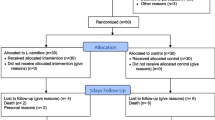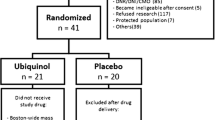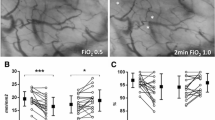Abstract
Purpose
We evaluated the relations among the arterial carbon monoxide (CO) concentration, heme oxygenase (HO)-1 expression by monocytes, oxidative stress, plasma levels of cytokines and bilirubin, and the outcome of patients with severe sepsis or septic shock.
Methods
Thirty-six patients who fulfilled the criteria for severe sepsis or septic shock and 21 other patients without sepsis during their stay in the intensive care unit were studied. HO-1 protein expression by monocytes, arterial CO, oxidative stress, bilirubin, and cytokines were measured.
Results
Arterial blood CO, cytokine, and bilirubin levels, and monocyte HO-1 protein expression were higher in patients with severe sepsis/septic shock than in non-septic patients. Increased HO-1 expression was related to the arterial CO concentration and oxidative stress. There was a positive correlation between survival and increased HO-1 protein expression or a higher CO level.
Conclusions
Arterial CO and monocyte HO-1 protein expression were increased in critically ill patients, particularly those with severe sepsis or septic shock, suggesting that oxidative stress is closely related to HO-1 expression. The HO-1/CO system may play an important role in sepsis.

Similar content being viewed by others
References
Scott JR, Chin BY, Bilban MH, Otterbein LE (2007) Restoring HOmeostasis: is heme oxygenase-1 ready for the clinic? Trends Pharmacol Sci 28:200–205
Hoetzel A, Dolinay T, Schmidt R, Choi AMK, Ryter SW (2007) Carbon monoxide in sepsis. Antioxid Redox Signal 9:2013–2026
Zegdi R, Perrin D, Burdin M, Boiteau R, Tenaillon A (2002) Increased endogenous carbon monoxide production in severe sepsis. Intensive Care Med 28:793–796
Moncure M, Brathwaite CE, Samaha EMA, Marburger RRN, Ross SE (1999) Carboxyhemoglobin elevation in trauma victims. J Trauma 46:424–427
Levy MM, Fink MP, Marshall JC, Abraham E, Angus D, Cook D, Cohen J, Opal SM, Vincent JL, Ramsay G (2003) 2001 SCCM/ESICM/ACCP/ATS/SIS international sepsis definitions conference. Crit Care Med 31:1250–1256
Bone RC, Balk RA, Cerra FB, Dellinger RP, Fein AM, Knaus WA, Schein RM, Sibbald WJ (1992) Definitions for sepsis and organ failure and guidelines for the use of innovative therapies in sepsis. The ACCP/SCCM consensus conference committee. American College of Chest Physicians/Society of Critical Care Medicine. Chest 101:1644–1655
Knaus WA, Draper EA, Wagner DP, Zimmerman JE (1985) APACHE II: a severity of disease classification system. Crit Care Med 13:818–829
Vincent JL, Moreno R, Takala J, Willatts S, De Mendonca A, Bruining H, Reinhart CK, Suter PM, Thijs LG (1996) The SOFA (sepsis-related organ failure assessment) score to describe organ dysfunction/failure. On behalf of the Working Group on Sepsis-Related Problems of the European Society of Intensive Care Medicine. Intensive Care Med 22:707–710
Ohta K, Terai H, Kimura I, Tanaka K (1999) Simultaneous determination of hydrogen, methane, and carbon monoxide in water by gas chromatography with a semiconductor detector. Anal Chem 71:2697–2699
Bachelet M, Mariethoz E, Banzet N, Souil E, Pinot F, Polla CZ, Durand P, Bouchaert I, Polla BS (1998) Flow cytometry is a rapid and reliable method for evaluating heat shock protein 70 expression in human monocytes. Cell Stress Chaperones 3:168–176
Tarng DC, Huang TP, Liu TY, Chen HW, Sung YJ, Wei YH (2000) Effect of vitamin E-bonded membrane on the 8-hydroxy 2′-deoxyguanosine level in leukocyte DNA of hemodialysis patients. Kidney Int 58:790–799
Pasquini A, Luchetti E, Marchetti V, Cardini G, Iorio EL (2008) Analytical performances of d-ROMs test and BAP test in canine plasma. Definition of the normal range in healthy Labrador dogs. Vet Res Commun 32:137–143
Bauer M, Huse K, Settmacher U, Claus RA (2008) The heme oxygenase-carbon monoxide system: regulation and role in stress response and organ failure. Intensive Care Med 34:640–648
Morimatsu H, Takahashi T, Maeshima K, Inoue K, Kawakami T, Shimizu H, Takeuchi M, Yokoyama M, Kaytayama H, Morita K (2006) Increased heme catabolism in critically ill patients: correlation among exhaled carbon monoxide, arterial carboxyhemoglobin, and serum bilirubin. Am J Physiol 290:L114–L119
Banks JG, Foulis AK, Ledingham IM, Macsween RN (1982) Liver function in septic shock. J Clin Pathol 35:1249–1252
Yachie A, Toma T, Mizuno K, Okamoto H, Shimura S, Ohta K, Kasahara Y, Koizumi S (2003) Heme-oxygenase-1 production by peripheral blood monocytes during acute inflammatory illnesses of children. Exp Biol Med 228:550–556
Maines MD (1997) The heme oxygenase system: a regulator of second messenger gases. Annu Rev Pharmacol Toxicol 37:517–554
Jao HC, Lin YT, Tsai LY, Wang CC, Liu HW, Hsu C (2005) Early expression of heme oxygenase-1 in leukocytes correlates negatively with oxidative stress and predicts hepatic and renal dysfunction at late stage of sepsis. Shock 23:464–469
Motoyama T, Okamoto K, Kukita I, Hamaguchi M, Kinoshita Y, Ogawa H (2003) Possible role of increased oxidant stress in multiple organ failure after systemic inflammatory response syndrome. Crit Care Med 31:1048–1052
Pascual C, Karzai W, Meir-Hellmann A, Oberhoffer M, Horn A, Bredle D, Reinhart K (1998) Total plasma antioxidant capacity is not always decreased in sepsis. Crit Care Med 26:705–709
Tamion F, Richard V, Renet S, Thuillez C (2006) Protective effects of heme-oxygenase expression against endotoxic shock: inhibition of tumor necrosis factor-α and augmentation of interleukin-10. J Trauma 61:1078–1084
Melley DD, Finney SJ, Elia A, Lagan AL, Quinlan GJ, Evans TW (2007) Arterial carboxyhemoglobin level and outcome in critically ill patients. Crit Care Med 35:1882–1887
Suttner DM, Dennery PA (1999) Reversal of HO-1 related cytoprotection with increased expression is due to reactive iron. FASEB J 13:1800–1809
Acknowledgments
This study was supported by the Japan Society for the Promotion of Science [Grant-in-Aid for Scientific Research (C) no. 18591991].
Author information
Authors and Affiliations
Corresponding author
Rights and permissions
About this article
Cite this article
Takaki, S., Takeyama, N., Kajita, Y. et al. Beneficial effects of the heme oxygenase-1/carbon monoxide system in patients with severe sepsis/septic shock. Intensive Care Med 36, 42–48 (2010). https://doi.org/10.1007/s00134-009-1575-4
Received:
Accepted:
Published:
Issue Date:
DOI: https://doi.org/10.1007/s00134-009-1575-4




